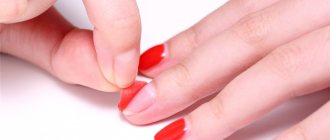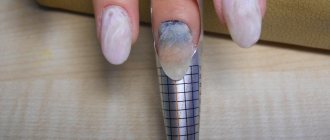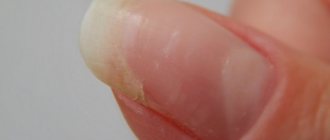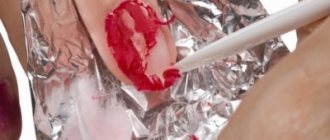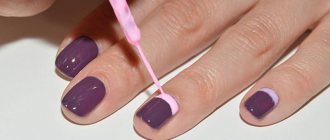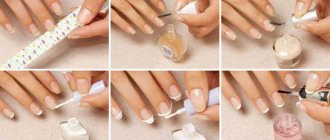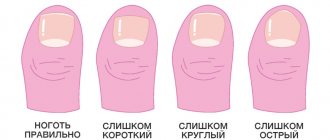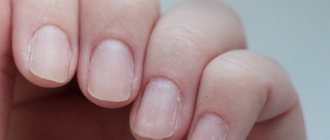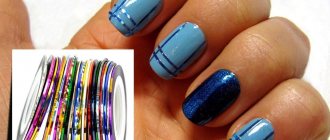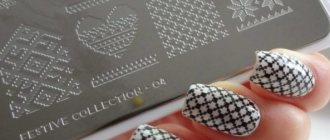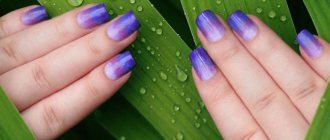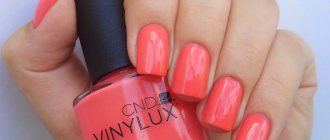If your nail is broken under gel polish, you can make initial repairs at home using a tea bag or manicure glue. The master can offer more serious strengthening agents: liquid and modeling gels, acrylics, fiberglass, fiberglass, silk.
If a nail breaks at the root, you need to do extensions. But if it is damaged to the point of bleeding, the injury must first be treated with chlorhexidine, antibiotic ointment and a bandage. You can’t walk around with a broken nail for a long time and repair it with superglue. And you can avoid the problem with high-quality manicure and materials, strengthening the plates with vitamins, and taking precautions when doing homework.
What to do if your nail breaks until it bleeds?
Firstly, if the gel polish on the nails is cracked and along with it the nail is injured to the core, then it is better to forget about the perfect manicure until the plate is completely restored.
You have to sacrifice beauty for health! If a nail breaks to the point of bleeding or at the root, you should not start thinking about how to glue it, but first properly treat the wound with chlorhexidine, hydrogen peroxide or any antiseptic. Beauty is beauty, but health is much more important!
Next, wrap it with a plaster or bandage and leave the injured finger alone until the wound is completely healed, after which it is recommended to seek professional help at a salon. During healing, you need to promptly change the dressing material and lubricate the cuticle with products that promote rapid nail growth. If you plan to contact the hand, the nail on which has broken at the root, with water or chemical reagents, you must wear a rubber fingertip or even special protective gloves.
To avoid aggravating the situation, it is strongly not recommended to repair a deep plate rupture yourself.
After the wound has completely healed, you can think about how to fix the situation with your damaged manicure. The ideal option is to contact a professional. In the salon, to the question “Gel polish is cracked, how to save it,” the master will most likely answer with an offer to fix the broken nail with biogel. This is an innovative drug containing many healing substances, including protein. With the help of biogel, damaged layers of the plate and nail bed will be restored in record time. In addition, it perfectly protects wounds from infections and germs.
Biogel restoration technique
This is a universal tool that can be used for both extension and restoration of a broken nail.
This is an easy way to restore your nails and takes less than 30 minutes. There are only three stages:
- Apply biogel.
- Dry.
- Apply base, decorative gel polish and top. Dry in a UV lamp after each application.
Biogel does not tolerate the proximity of household chemicals, so cleaning the house and washing dishes should only be done with rubber gloves.
Why do nails break?
Both a natural nail and one coated with gel polish or shellac can break.
In the first case, the reasons may be:
- excessive mechanical stress on the nail plates;
- excessive grinding of peeling nails;
- increased fragility due to a lack of certain vitamins,
- health problems (disturbances in the gastrointestinal tract, endocrine system and others),
- frequent contact with household chemicals and water, which causes the nail plates to become thinner and often break.
The main reason why an artificial nail can break is mechanical impact.
If you hit something hard on a nail plate coated with gel polish or shellac, a crack may appear or a piece may even break off.
If there is constant mechanical stress on the nails (typing on a keyboard and other factors), the coating often begins to peel off.
Due to a strong impact, such as a blow, a crack may even appear at the base or in the middle of the nail plate. But sometimes it happens that the appearance of cracks and chips on artificial turf is due to the unprofessionalism of the master: due to improper construction of the nail architecture or excessive removal of the top layer.
Particular attention should be paid to manicure care on the first day after extensions or gel polish coating: you should not experience sudden temperature changes on it, and also do not get too carried away with water procedures
Influence of decorative coatings
Why do women's extended nails break? Do your nails break under gel polish or even after regular polish? The reason is the negative impact on the plate of chemical compounds in the coating composition and the mechanical factor.
Nail polishes contain drying components that take away moisture from the nail plate and weaken it. Products containing toluene, formaldehyde, formaldehyde resin, dibutyl phthalate, and camphor greatly dry and irritate nails. Therefore, it is better to choose varnishes with the big5free formula for nail decoration, which do not contain these 5 toxic components. Also, give your nails a rest for at least 5-7 days between coating with decorative varnishes, gel polish or extensions.
Why do nails break after gel polish? In fact, the reason is not in the coating, which gives a bright, long-lasting manicure, but in errors when applying or removing it. They are the ones who provoke brittleness, peeling and cracking of the plate. To avoid this, you need to carefully choose a specialist. This must be a person with education and experience.
Regardless of what decorative coating you are removing, gel polish or regular, do everything correctly and carefully. Do not pull on pieces of polish that have peeled off from the nail plate. Do not try to peel them off, because along with the varnish you risk removing the top layer of the nail. Remove regular varnish using removers without acetone, and remove gel coating or extended nails only with a professional using a hardware method.
Nail extension repair
Extensions are done with acrylic tips. They do not have a living structure, so if they break off, they can be glued with synthetic glue for plastic (superglue, “Moment”). The fastening materials are the same - filter paper, silk strips, paper plaster.
The technology for gluing the extended plate is as follows:
If repairing the extended nail is impossible, you can replace it with a new one.
Apply glue to the nail and place a cut-out paper strip on top of it.
Place another drop of glue on top of the strip. Apply the third layer of glue on top of the dried second.
Treat the repair area with a nail file. Apply varnish on top.
Another repair option is to replace the broken tip with a new one.
Tips for preventing the problem
To keep your nails in good condition, you need to adhere to the following recommendations:
- saw in one direction, this way you can prevent the appearance of cracks;
- do not cut it too short to avoid nails growing into the meat;
- massage your hands regularly;
- steam the nail plates before the manicure procedure;
- eat meat and fish dishes, herbs, vegetables and fruits daily;
- thoroughly dry your hands after contact with water;
- use only high-quality tools and materials for nail care.
You can keep your nails in good condition not only by following the necessary rules, but also by using the services of specialists. Salons offer the following procedures:
- wax or paraffin applications;
- spa or aromatherapy;
- Japanese manicure;
- ultraphoresis;
- sealing;
- biogel.
Such procedures should only be performed by trusted specialists.
Healthy and neat nails indicate not only the neatness of a person, but also the condition of his internal organs. Therefore, you need to regularly take care of your body, consume as many vitamins as possible and give up bad habits. It is quite difficult to prevent nail damage, but if it has already happened, you need to approach this situation wisely.
Errors in care
The main mistake is a lack of moisture, leading to loss of elasticity of the plate. For some reason, too hard, dry, inflexible nails often break across or along from any touch.
Excess moisture that occurs during long and constant contact with water also has a bad effect on nails. The scales that make up nails quickly absorb moisture and become soft and loose. As a result, they get injured much more easily.
Errors in care include errors when performing a manicure or pedicure.
The most common of them include:
- intensive grinding with a polishing file, which not only gives smoothness and shine, but also injures, thins the plate, and makes it vulnerable to harmful external factors;
- Processing the free edge with a nail file in different directions, “back and forth”, and not in one;
- Dry nail cutting. This is often the reason why long nails break. They should be trimmed when they are wet: after a bath or shower;
- An unfortunate shape, with sharp edges that cling to everything. The best shape for preventing breakage is considered to be square with rounded edges or oval.
The reason why fingernails break and peel is often due to cleaning the house or washing dishes without protective gloves. Contact with water and household chemicals irritates nails and hand skin. Aggressive components from cleaning products dry out the plate, disrupt the lipid balance, and make it weakened and fragile.
Likewise, frequent hand sanitizers with alcohol have a negative effect on your nails. If you need to constantly use antiseptics, it is important to take care of additional hydration of the treated areas, because compositions with ethyl alcohol deprive the skin of moisture and cause peeling and fragility.
How to fix a broken nail
First, it is worth noting that a nail that is more than 1/3 broken is not suitable for repair.
The matter can be corrected only with minor damage. But even after repair, you shouldn’t hope that the effect will last for a long time - such a nail can last only 2-3 days, if you handle it very carefully - a week.
| Caution: if the nail plate is broken in such a way that the soft tissue is damaged, it is better not to try to repair it. |
The fact is that in such cases there is a high risk of infection getting into the wound.
The only correct solution would be to cut all nails to the length of the broken one in order to provide your hands with an aesthetic appearance. The damaged area should be regularly treated and the condition of the phalanx tissue should be monitored. If the option of cutting all of them into one is absolutely not suitable for a broken nail, you can try to save the manicure.
Natural nail repair
To start nail repair, you need to have the following tools and tools: 1. Means for degreasing the nail plate. If you don’t have it, you can replace it with regular medical alcohol.
2. Silk with a self-adhesive base.3. Special glue for nails. It is unacceptable to replace it with Moment or similar products, since such compositions aggressively affect even healthy nail plates. If you don’t have a special one at hand, medical glue will do.4. A nail file or buff with low abrasiveness (to reduce injury to the damaged nail).5. Acrylic powder for fixing the glue layer, giving a natural shade to the nail surface, and also masking the edges of the fabric. All of the above is also sold as a special set, which is convenient to use both at home and while traveling.
Stages of natural nail repair:
1. First you should clean the surface of the nail with a soft buff. They need to move from the base of the nail upward.2. Degrease the nail plate with a special liquid or alcohol.
3. Remove the film from a piece of fabric (silk) and stick it so that the crack is completely covered. Then apply a drop of glue to the applied layer and dip the nail plate into the powder. After the glue dries a little, excess powder is removed. If necessary, the steps are repeated. If glue gets on the skin, remove it with an orange stick.
4. After the overlay has completely dried, the surface of the nail is polished with a nail file. This is necessary to remove the adhesive layer so that the nail plate becomes as smooth as possible.
Polishing is done with careful, gentle movements so as not to provoke a new crack. Then oil is applied to the surface of the nail and cuticle and polished with a buff. This is necessary in order to hide the break border as much as possible.
5. After this, apply 2 layers of opaque varnish. These manipulations will completely hide the crack.
If a piece of your nail breaks off, you can try to build it up using gel polish.
How long can you wear gel polish?
Technologists advise walking with the coating for no more than 2-3 weeks. But often girls wear gel polish for a month, or even longer. However, they do not understand that they can damage the nail plate. Prolonged wear puts stress on the tip of the nail plate, its root suffers from the weight of the coating. And this can lead not only to breakage, but also to deformation of the nail plate.
Causes
There are many factors that contribute to gel polish cracking on your nails.
Such reasons include:
- improper coating application;
- poor quality manicure materials;
- applying the gel in a layer that is too thin or thick;
- influence of external factors;
- unhealthy condition of the nail plate;
- incorrectly selected drying lamp;
- the presence of a sticky and greasy layer on the surface.
Gel polish can crack on both natural and extended nails. The integrity of the gel surface depends on the reason that provoked the development of this phenomenon. For example, if the manicure technique is violated, small cracks appear on the second day.
Results of incorrect application
The gel coating on the nail plate begins to crack if the technology was violated during the procedure.
Poor quality manicure results from the following reasons:
- improper cuticle removal;
- oily layer on nails;
- nails are not completely dry;
- the gel was applied to the plate after applying the cream;
- when gel polish is applied in a very thin or thick layer;
- if the base product and gel are from different manufacturers;
- with improper polishing of the nail surface.
If the master does not follow the application technology, the gel polish begins to crack on the nails within the first week after the manicure.
External factors
If the varnish is cracked, this may be due to external factors. The substances contained in household chemicals are considered the most aggressive to gel manicure.
The nail coating is damaged by:
- washing powder;
- some creams and ointments;
- detergents (especially those that clean the surface of bathtubs and sinks and contain abrasive particles);
- soap
The integrity of the gel is compromised when working with soil without protective gloves. Temperatures that are too low or high also reduce the wear time of gel polish.
Nail condition
Most often, cracks form due to a pathological condition of the nails. If the stratum corneum is very thin or soft, then the gel polish begins to quickly become damaged.
Under frequent exposure to water, powder, and detergents, the coating bursts because it does not attach well to the nail surface.
Thick layer of gel polish
Cracks begin after the material is applied too thickly.
The layer at the top of the manicure dries and decreases in size. The gel coating below, on the contrary, stretches. As a result of this process, cracking occurs.
Drying lamp
When this indicator is lower, the product does not dry completely. The sides remain wet.
To check the quality of drying, press on the coating with a pusher. If a dent appears, the gel has not dried. With incomplete drying, strength decreases.
Exposure to water
Frequent contact with water negatively affects manicure. Washing your hands frequently can cause your manicure to crack.
Remaining sticky layer
If the sticky layer is applied incorrectly or is not completely removed, then the gel polish does not adhere well to the nail plate. Cracks due to its residue appear within a few days.
Poor quality materials
One of the common reasons for cracking gel on nails is the use of low quality materials.
Usually the price for these accessories is low. Such materials are not branded.
Other reasons
Gel polish also cracks due to the following reasons:
- use of antibiotics;
- stomach diseases;
- pathologies of the heart and blood vessels;
- diseases of the endocrine system.
Such a manicure can be damaged due to hormonal changes in women, including during menstruation and pregnancy.
In rare cases, individual intolerance to the components included in the manicure product is possible.
Is gel nail polish harmful?
This is actually a myth! Gel polish does not damage the nail plate in any way. Then why do girls complain that after artificial coating the quality of their nails becomes much worse? It's all about violating the technique of manicure and removing gel polish, as well as wearing the coating for a long time. Unfortunately, this can lead to consequences such as:
- thinning of the nail plate;
- lamination and fragility;
- injury to the nail plate;
- painful sensations when touching the nail plate;
- onycholysis;
- fungal nail diseases.
Who is to blame for this? Sometimes it’s a non-professional manicurist, and sometimes it’s the manicure owners themselves. But not the material! So the assumption that gel polish spoils nails is a myth.
Why do all the above problems arise and how to restore the nail plate after them? Let's figure it out.
Quick restoration of nails after gel polish
Damaged nails must be treated so that the already thinned and injured plate does not become even more deformed. To do this, you will need products that can be purchased at pharmacies or special departments of stores.
So how to restore nails after improper removal of gel polish and damage to the top layer? There are several effective means for restoring the nail plate. It is advisable to do the procedures daily and alternate them with each other.
Baths are very effective in answering the question of how to restore nails after gel polish at home. Only warm water is used. The procedure lasts 20-30 minutes. Baths are needed to prepare the skin of the hands and nails for the use of the nourishing product.
Bath with salt and lemon
Bath composition:
- Sea salt. It is enough to dissolve 2-4 teaspoons in a small bowl. The solution will disinfect and strengthen your nails.
- Chamomile - acts as an antiseptic, softens and expands the pores on the plate.
- Sage – eliminates dryness and flaking.
You can add a few drops of lemon juice into the bath to better soften the skin and plate. Or add a few drops of iodine to sea salt. Such a solution will imitate sea water and have a strengthening effect.
Other useful baths:
- with potato broth - softens and nourishes at the same time;
- 1 teaspoon each of apple cider vinegar and soda - helps restore in a short time after treatment for fungal diseases.
After using the bath, hands are thoroughly wet and a rich nourishing cream is applied. To increase its effectiveness, you can add 1-2 drops of essential oil: jojoba or almond.
Masks are also effective. They can be prepared from the following ingredients:
- Gelatin - 2 teaspoons of gelatin are dissolved in warm water, the nails are lubricated with rich cream and placed in the prepared liquid. Keep for 10-15 minutes. Nails are restored and strengthened, and their growth accelerates.
- A few drops of essential oil are dissolved in olive oil, for example, ylang-ylang, myrrh, apricot, lavender or cedar rose. Apply to the plate and leave until absorbed. The excess gets wet. The mask nourishes with beneficial microelements, fills damaged voids, smooths out scales and makes the surface smooth.
- Clay. It is separated and placed on the plate. Keep for 30 minutes. Afterwards, wash off and rub in the nourishing cream. Clay strengthens the nail and repairs damage.
- Cosmetic paraffin. You need to melt it in a water bath. Fingers are dipped into it for 10 minutes. At the end of the procedure, the residues are smoothly rubbed in and oilcloth gloves are put on your hands. Leave them on for 1-2 hours. Paraffin seals well and smoothes out roughness, nourishes and moisturizes the skin.
Nail restoration polish after gel polish
Therapeutic varnishes help restore the nail plate. This coating protects the nail, fills voids and evens out the surface. It contains vitamins and minerals, especially calcium.
Application of medicinal varnish
Medicinal varnishes include:
- Smart enamel. Available in a wide range. Apply daily. Strengthening of the plate can be seen after two weeks.
- Mavala Scientific. Apply every other day, the result is visible after a month. The product is especially effective for split nails.
- IBX System. A professional product used in salons. Nourishes and restores the plate in the shortest possible time.
- Eveline. It acts in several directions and stimulates nail growth. Apply once every 3 days. The effect occurs after 2-3 weeks.
These and other products can be purchased at the pharmacy chain. The healing coating is usually colorless; colored varnish can be painted over it.
How to strengthen peeling and brittle nails in a beauty salon
Japanese nail sealing
Each salon calls this procedure differently: Japanese lamination, Japanese manicure, sealing. In essence, this is the same thing - improving the health of nails and securing the results for a long period.
How can sealing strengthen your nails so they don't peel?
The process begins with cleansing the nail plate and moisturizing the cuticle. Then a paste is applied to nourish the nails, which contains beeswax and microelements. It is rubbed in with a suede nail file, filling the damage on the nail plate. This is followed by polishing the nail and applying a special powder with a protective effect. The sealing procedure ends with a hand massage with herbal bags. The seal lasts for about 20 days, leaving nails healthy, shiny, well-groomed and strong. After this procedure, the nails will not peel off.
Strengthening with gel
How to strengthen peeling nails with biogel? Applied in a thin layer, it creates a kind of protection against mechanical stress. Due to calcium and special substances in its composition, the nail remains elastic, stops breaking and begins to grow quickly.
Hot manicure
This procedure is based on heating the cream and oil, which promote the penetration of beneficial substances into the skin and nails. If paraffin therapy cannot be performed on damaged hand skin, then hot manicure, on the contrary, is used in the presence of cracks and hangnails. After the procedure, everything tightens and heals, nails grow faster, do not peel, and the cuticle slows down its growth.
SPA manicure
The basis of a SPA manicure is a relaxing effect on the hands using various cosmetics at the request of the client. Among the types of such manicure there are strengthening, rejuvenating, moisturizing, and, as a rule, they are used in combination.
The SPA manicure procedure includes baths with salt or algae, peeling, the use of special oils and masks to nourish the skin of the hands and nails, as well as a relaxing massage. This procedure for strengthening peeling nails does not involve a trimmed manicure, only a European one. Therefore, when choosing this type of nail care, take this into account.
Silk reinforcement
Peeling nails can be strengthened with both gels and silk. This procedure is especially often used to maintain shape and length for a long time. Applying a thin layer of silk to the nail, it is secured and polished. Thus, the nail plate does not thicken, the nail does not flake or break, and the polish adheres better to such a surface. It is good to strengthen peeling nails with silk before going on vacation. Then you won't have to worry about your nail breaking.
Decorative gel
Coating with decorative gel (Shellac, etc.) does not in any way affect the treatment of nails and their healing. Although the nail plate thickens due to the coating, weak and soft nails are protected for a long time. If you do healing procedures first, then after them there is nothing left but to strengthen your peeling nails with gel polish for a better effect.
Whitening
The color of nails depends on many factors, yellow certainly indicates problems. The whitening procedure is carried out in a salon using salt or oil baths and special cosmetics. After this procedure and polishing with a brush, the whiteness is restored. If the nails are too neglected, you will need to carry out more than one procedure.
Grinding and polishing nails
As a rule, this procedure is included in a standard manicure service. However, for peeling nails, it may be carried out in combination with health-improving operations.
Sanding is the process of smoothing the nail, removing yellowness and roughness from its surface, giving it a healthy shine and smoothness. The procedure has a preventive effect on the diseased nail, since when the top layer of the nail plate is removed, all bacteria are removed.
Upon completion of sanding, the nail plate and cuticle are covered with special oils, creams or lotions that nourish and restore peeling nails. However, this procedure cannot often be done.
Read material on the topic: Medical hardware pedicure
Nail masks
A good effect is obtained from masks for peeling, brittle and dry nails. These professional products may be ready-made, or the master will mix the necessary ingredients in your presence. As a rule, nail masks need to be done more than once, but in combination with other procedures.
For many men and women of different ages and social status, caring for peeling nails has long become an urgent need. And there is nothing unusual or reprehensible in this: the desire to feel cheerful, to look always fresh, bright, irresistible is natural and understandable.
In addition, these days you no longer have to spend a lot of time on this or perform complex and unpleasant procedures at home. It is much easier to seek help from real professionals - the Veronika Herba beauty and health center, equipped with effective and modern equipment. There are two such centers in Moscow – near Timiryazevskaya metro station and Otradnoye metro station.
Step by step nail repair
Especially for skeptics, the ambulance chose for clarity the option without complications, but with an asterisk. We bet you were sure that if a nail broke at the root and the tip fell off, then there was nothing left to do but cry over the trash can and trim the rest?
Ha! The professionals grin and roll up their sleeves. Everyone loves before and after photos, right? So, here you go.
Everything can be solved, your hands are not for boredom! Detailed instructions with photos will tell you how to seal a nail.
Preparation
The nail needs to be treated with a buff, remove the gloss and make the surface of the nail slightly rough. The process is similar to preparing for applying gel polish. By the way, if your nail breaks under gel polish, first remove the old coating, fix it and get a new manicure. If the nail is cracked on the side, file down the jagged edge a little. If you need to glue the tip that has fallen off, then, on the contrary, there is no need to file the broken edge. Otherwise, the “gears” will not fit together. Finally, thoroughly degrease and disinfect.
Main action
Apply glue to the nail:
Attach the broken tail and hold for a few seconds, 15-20, so that the glue “seizes”:
This is what the nail looks like both broken and glued:
Now it's the bandage's turn. If the material is adhesive-based, then the fabric can be immediately applied to the plate. If you use a tea bag or non-woven fabric as a bandage, first spread glue on the plate, then place the fabric.
The piece should not be even; all excess is cut off with scissors and filed with a nail file. Do not skimp on fabric; it is better to cover the entire plate for strength. The larger the area, the lower the pressure. The laws of physics also apply in the nail world.
Apply a layer of glue on top of the bandage, smooth it out and dry:
Armed with a buff, carefully polish the nail. Align the edges of the bandage with the plate. If there are any protruding edges and glue clumps, file them down with a coarse file.
You can apply a control layer of glue to the polished nail and lightly buff it again.
Result
Voila! Like new. Now you can paint your nails as usual. Look at the picture:
The nail on the left finger is broken on the side, on the right finger it is broken at the root. Breakdowns are marked with a red line. Nothing is impossible. This technique can be used to repair almost any damage to nails of different shapes and lengths. The proof is in the photo.
The location of the crack does not matter. If the nail is broken in the middle, the repair algorithm will not change. As long as the skin is not damaged. Don't neglect safety precautions.
By the way, when using gel polish, you can use a base coat instead of glue. In this case, you need to put a base layer on the nail and a bandage on top. Soak the bandage thoroughly with the base, you can add an additional drop on top. Only after this polymerize in a lamp.
Thanks to the nail emergency specialists for the master class. Now you can handle repairs of any complexity. If your nail suddenly breaks, you can fix it at home like a real professional. If such breakdowns occur regularly, look for the reason. Perhaps something tasty and healthy is missing from your diet. Eat fruits, vegetables, grains, meat and other good foods more often. Take care of yourself and your health. Strong claws to everyone!
What to do?
It is recommended to prescribe a regimen for restoring the health of a natural manicure only after you find out why your nails began to peel after repeated application of gel polish.
To eliminate damage to the nails, you first need to eliminate the causative agent of such problems.
However, there are general restorative measures that will help eliminate detachments:
- Balance your diet. A lack of vitamins and microelements always affects the state of general and local immunity, therefore, to strengthen teeth, hair, and nails, you should normalize your diet;
- Take a break from gel polish. After removing the work, do not reapply the pigment. Allow the nails to rest for 3 months until a new plate grows;
- Use restoring varnishes, which visually look like ordinary transparent compounds, but gradually normalize the surface structure;
- Once a week, do a manicure yourself, removing the overgrown free edge and adjusting its shape. This way you will reduce the risk zone in which the coating can break.
Additionally, procedures should be carried out to increase local immunity: steaming baths, caring compresses, masks, lotions for marigolds. This way you can nourish the matrix with useful microelements, which will speed up the process of restoring your manicure.
Every day before going to bed, apply essential oil (tea tree, lavender, fir, eucalyptus, etc.) to the entire nail bed, including the side ridges and cuticle area. This way you will increase the elasticity of the nail, preventing its premature breakage, speed up the process of regeneration of epithelial cells in sensitive skin, preventing the appearance of hangnails and other problems in the periungual area.
How to repair at home?
If the nail plate is damaged, do not rush to trim the broken area and align all other nails to its remaining length. There are many proven ways to correct this situation using the most common means.
To repair nails you will need the following tools:
- disinfectant;
- special fabrics (linen, silk, artificial fiberglass);
- glue for nail restoration;
- buffs;
- nailfile.
How to seal using a tea bag?
The tea bag is made of thin fiber paper. By applying this material to the damaged nail plate, you can hide all the resulting defects. The result is not inferior to salon techniques that use silk coating. To repair a nail you will need:
- tea bag;
- high-quality base coat;
- nail file;
- device for grinding and polishing;
- scissors;
- colored varnish;
- top
Gluing procedure:
- remove nail polish;
- cut out a rectangle from the bag with a shape corresponding to the nail;
- apply a base coat to the plate and let it dry;
- attach the cut piece and smooth it, eliminating bubbles and unevenness;
- put the next layer of base on the nail;
- remove excess cellulose from the edge of the nail using a file;
- apply decorative colored varnish.
The video demonstrates how to repair a nail using a tea bag:
How to save using special glue?
You can restore your nail yourself using special glue as follows:
- wash and dry your hands well;
- put your hands in warm water to soften the plate;
- apply special glue to the nail and spread evenly over the surface using an orange stick (you can also use a toothpick);
- attach the broken part and press gently;
- after the segment is fixed, remove excess adhesive;
- perform polishing using a special file, performing the procedure in only one direction;
- apply protective varnish.
How does gel polish compare favorably with regular polish?
Firstly, it is easier to apply - if a simple varnish, even the freshest one, is prone to gaps and stripes on the nail, then the gel, due to its density, instantly lies on the nail plate in an even layer. Often, gel polish does not require reapplication.
The second well-known advantage is the durability of the coating. This advantage can be a disadvantage for girls whose nails grow quite quickly, but if the length of your nails does not change much over the course of a week, long-lasting polish will be your salvation. Gel coating is also suitable for those with fragile, brittle nails: the gel literally “walls up” all the defects of the plate.
How to do a manicure with gel polish at home?
We will talk about all stages of this process.
Nail preparation
Any manicure should always begin with proper nail preparation. First of all, you should work with the cuticle - it should either be trimmed or carefully pushed back.
How to remove cuticle?
Even those with thin skin prone to injury can remove it, but do not forget to steam your fingers first. Soak your hands in the hot bath and then begin removing the cuticles. First, lift it with a special spatula - the skin should completely move away from the nail. After this, trim the cuticle using a sharp trimmer or well-sharpened thin scissors. If you do injure the skin around your fingers, immediately treat the wounds with peroxide and lubricate your nails with coconut or apricot oil.
If the skin around the nails is quite dense and not prone to injury, you can remove the cuticle “dry” - in this case, the procedure will be exactly the same, with the exception of the first step with warming up the fingers.
If you don’t do a trimmed manicure on principle, it’s still worth steaming the cuticle - so that it’s easier to push it back with a spatula. Even with this method of dealing with cuticles, the skin may be slightly damaged, so keep peroxide and nourishing cream on hand.
After removing or pushing back the cuticle, you should proceed to giving the nails the desired shape. The most popular one is square on short nails, but if the nail plate is set quite low, choose an oval shape - it will visually “stretch” your fingers. Everyone knows how to shape nails - using a file. But opt for a glass instrument. Do not cut your nails with clippers or scissors if they are prone to splitting - carefully file the plate to the required length.
After shaping, polish the surface of the nail with a buff, then remove dust with a brush and apply nourishing oil or cream to your fingers. Before applying gel polish to your nails, make sure that their shape is uniform and that there are no burrs or cuticle particles left around.
Varnish coating
What do you need to do a gel manicure? The basic necessary tool is an LED or UF lamp. Without it, the coating will not adhere to the nail properly, and the drying process will take much longer.
The gel polish firmly settles on the nail, therefore, to facilitate the removal process in the future, it is necessary to apply a primer to the plate - it will smooth the surface of the nail and will not allow the polish to be firmly “absorbed.” You'll thank yourself for taking this step before you remove the gel polish.
After applying the gel, you need to paint your nails with a topcoat, which will give the varnish shine and durability.
Now let's move on to the procedure.
First, coat your nails with primer, then proceed to applying the gel itself. Make single and confident movements with the brush, do not smear the polish on the surface of the nail. Place your hands into the LED lamp, being careful not to smear the gel, repeat the process if necessary. If the color saturation seems insufficient to you, apply a second coat of varnish.
After the gel, fix the result with a top coat - a protective glossy coating that will provide the varnish with greater durability.
List of sources
- vokrug-nas.ru
- ufologov.net
- salon-nagorkogo.ru
- nails-health.ru
- jawoman.ru
- idealnyi-manikur.ru
- ameno.ru
How to fix a cracked nail with gel polish
Even if a break occurs under the decorative coating, you can fix it yourself so as not to spoil the result of the manicure, maintaining the healthy condition of your nails.
Required Tools
If, instead of visiting a salon, you decide to restore the manicure effect yourself, first pay attention to the selection of consumables and compositions in order to competently complete the job.
For manipulations you need:
- File;
- Oily hand cream or Vaseline;
- Cotton pads;
- Metal pusher or orange stick;
- Alcohol;
- Foil.
From the compositions, prepare standard solutions for applying gel polish: base, top, color pigments, ultraviolet lamp.
Pre-treat all tools with an antiseptic to prevent infection or dirt from getting under the surface of the nail.
Step by step instructions
Typically, the work takes about an hour or an hour and a half, which depends on the severity of the damage to the nail plate and the dense coating applied by the master.
Work begins by removing the previous coating:
- File off the top layer of the decorative coating.
- Lubricate your finger with rich cream.
- Moisten cotton pads with alcohol and place on the tip of your finger, and wrap a small piece of foil on top.
- After 15 minutes, remove the compress and remove the softened solution using a metal pusher or an orange stick. If the gel adheres strongly to the surface, perform the manipulations again.
Then polish the damaged area and disinfect. Carry out the necessary manipulations to prevent infection under the skin if the crack is large.
To mask damage to the length of the plate, you can put a patch in the form of foil:
- Secure a small piece of foil folded in three times on the nail (to do this, use tape or adhesive tape on the inside). Cover it with primer and place it in the lamp for a minute.
- Cover the nail with foil base to the desired length of the free edge and cure the result again in the lamp. You need to dry twice as long as you usually dry.
- Paint your nails twice with colored gel polish, drying them alternately in a lamp, and then seal the result with top coat. After drying, remove the sticky layer from it using a cotton pad soaked in alcohol.
- Remove the foil; to do this, you can pry it off with tweezers from the inside.
If the manipulations are performed correctly, the nails will be strong and look natural. However, there is no need to grow long nails this way, as they will quickly break. It is worth making small patches with them so that they last until the next manicure correction.
